Know about Silkie chickens: Their origin & history, appearance, Hen vs rooster, Silkie chicken eggs & meat, Chicks at all ages, Silkie chicken rooster, pros & cons, price, owner’s suitability and many more.
Introduction
Silkie chickens, with their plush, cloud-like feathers and endearing personalities, have enchanted chicken keepers for generations. Their distinctive appearance and charming demeanor make them stand out in any flock, earning them a special place in the hearts of poultry enthusiasts worldwide.
Silkie Chicken’s Origin and History
Silkie chickens have a rich history that dates back to ancient China. They are believed to have originated in Asia, with the earliest records suggesting they were bred in China. Marco Polo even mentioned a “furry chicken” during his travels in the 13th century, which many believe referred to the Silkie.
Are Silkie Chickens a Hybrid or a Real Breed?
Real Breed
Silkie chickens are a true breed with distinct characteristics that have been maintained over centuries. They are not hybrids but have a rich history and consistent traits that define them as a unique breed.
Naming
The name “Silkie” comes from their silky, fluffy feathers that resemble fur more than typical chicken feathers.
Silkie Chicken Appearance
Silkie Chickens: Rooster vs. Hen
Silkie chickens Color
Silkie chickens come in a variety of colors, including black, white, blue, and buff. Roosters usually have more vibrant plumage compared to hens. Their feathers are soft and fluffy, giving them a plush-toy appearance that makes them incredibly charming.
Size, Weight, and Shape
Silkie roosters typically weigh around 2-3 pounds, while hens are slightly lighter, averaging 1.5-2 pounds. Both have a compact, rounded body shape. Roosters tend to have a more prominent comb, but Silkies generally lack wattles, making them unique.
Uniqueness in Appearance
Silkie chickens stand out due to their unique feather structure. Unlike regular chickens, their feathers lack barbs, giving them their signature fluffy look. They have black skin and bones, five toes on each foot (instead of the usual four), and a walnut-shaped comb. These features make them truly one-of-a-kind in the chicken world.
Silkie Chicken Eggs
Silkie chickens Egg Colors
Silkie chickens lay small, cream-colored eggs that can range from light beige to slightly darker tan. These eggs are generally lighter than those from many other breeds.
Blue color egg-laying chickens as pets.
Egg Size
Silkie eggs are relatively small, typically weighing about 1.2 to 1.4 ounces each.
Silkie chickens Egg Production
Silkie hens are not prolific layers. On average, a Silkie hen can lay about 3-4 eggs per week, totaling around 12-16 eggs per month or roughly 150-170 eggs per year.
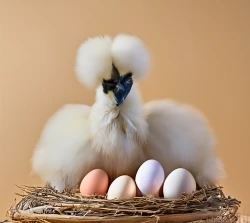
Egg Uniqueness
Silkie eggs are prized for their rich flavor and creamy texture. While they aren’t as large or numerous as eggs from other breeds, their superior quality makes them a favorite among Silkie owners.
Silkie Chicken Meat
Silkie chickens aren’t usually raised for their meat, but in some cultures, they are considered a delicacy. Their meat is darker and more flavorful than that of other chicken breeds, thanks to their unique black skin and bones.
In traditional Chinese medicine, Silkie meat is believed to have health benefits, such as boosting the immune system and improving overall vitality.
On average, a Silkie chicken can produce about 1-2 pounds of meat. While this isn’t a lot compared to larger breeds, the distinctive taste and perceived health benefits make it highly valued in certain cuisines.
Silkie Chicks
Raising Silkie chicks requires care and attention at various stages of their development. Here’s a helpful and brief guide to ensure your Silkie chicks grow up healthy and happy.
Appearance at Hatch
Newly hatched Silkie chicks are tiny, delicate, and look like little balls of fluff with soft, downy feathers. Their unique appearance is noticeable from the start.
At Hatch (0-1 Week)
Provide a warm, dry brooder with a temperature around 95°F. Ensure they have access to clean water and a starter feed formulated for chicks.
1-3 Weeks Old
Silkie chicks grow rapidly. Gradually lower the brooder temperature by 5°F each week until they are fully feathered. Continue providing chick starter feed and fresh water.
3-6 Weeks Old
Introduce Silkie chicks to outdoor conditions if weather permits. Provide a safe, enclosed area to protect them from predators as they begin developing their fluffy feathers.
6-12 Weeks Old
Transition Silkie chicks to a grower feed and ensure they have ample space for exploration and exercise. Monitor their development as they become more independent.
Food and complete nest setup for chicks.
12-20 Weeks Old
Introduce Silkie chicks to the rest of your flock if you have other chickens. Continue feeding them a balanced diet suitable for young chickens to support their growth.
20 Weeks and Beyond
Around 20 weeks, Silkie hens start laying eggs. Provide a nutritious diet to support egg production. By this stage, they will have their full adult appearance with characteristic fluffy feathers.
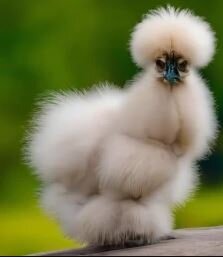
Silkie Roosters
Silkie roosters are beloved for their gentle and friendly nature, making them ideal for both experienced and novice chicken keepers alike. They exhibit less aggression compared to roosters of many other breeds and often develop strong bonds with their human caretakers.
Appearance
Silkie roosters have distinct characteristics that set them apart. They sport larger combs and wattles compared to hens, along with longer hackle feathers around their necks. Their plumage is exceptionally fluffy and silky, giving them a majestic and eye-catching appearance.
Crowing and Noise
While Silkie roosters do crow, their crowing is typically softer and less frequent than that of larger rooster breeds. This makes them a suitable choice for chicken enthusiasts who are concerned about noise levels but still desire a rooster’s presence in their flock.
Other Types of Silkie Chickens
Black Silkie Chickens
Black Silkies have striking black feathers, skin, and bones. They are just as friendly and gentle as other Silkies and make a unique addition to any flock.
Bantam Silkie Chickens
Bantam Silkies are a smaller version of the standard Silkie, but they share all the same characteristics. They are perfect for those with limited space who still want to enjoy the charm of Silkies.
Blue Silkie Chickens
Blue Silkies have beautiful blue-gray feathers. This color is a result of breeding and is not as common as the more traditional black or white Silkies.
Partridge Silkie Chickens
Partridge Silkies have a striking pattern with a mix of colors, including brown, black, and gold. They are visually stunning and add diversity to a flock.
Silkie Chickens Price
For Sale Silkie Chickens Price
The price of Silkie chickens can vary widely depending on factors such as their quality, age, and color. On average, you can expect to pay between $10 to $50 per bird. Show-quality Silkies or those in rare colors may command higher prices.
Where to Buy Silkie Chickens for Sale
Silkie chickens are available for purchase from various sources, including local breeders, poultry farms, and online hatcheries. Popular online sources include My Pet Chicken, Cackle Hatchery, and Murray McMurray Hatchery. When buying Silkie chickens, always ensure you choose a reputable source to ensure the health and quality of your birds.
Owner’s Suitability for Silkie Chickens
Suitable Owners
Experienced Chicken Keepers:
Owners with prior experience in raising chickens will appreciate the unique care requirements of Silkie chickens, including grooming and maintaining their fluffy plumage.
Families with Children:
Silkie chickens’ gentle demeanor and tolerance for handling make them ideal pets for families with children. They can be safely interacted with and provide educational opportunities for youngsters.
Urban and Suburban Dwellers:
These chickens thrive in urban and suburban environments due to their quiet nature and minimal space requirements. They are suitable for backyard coops without causing disturbance to neighbors.
Companion Animal Enthusiasts:
People seeking interactive and affectionate pets will enjoy Silkie chickens’ tendency to bond closely with their caretakers. They provide companionship and enjoyment through their docile behavior.
Unsuitable Owners
First-Time Chicken Keepers:
Silkie chickens, with their specialized care needs such as feather maintenance, may pose challenges for those new to poultry keeping.
Owners Seeking High Egg Production:
If the primary goal is high egg production, Silkie chickens may not be the best choice due to their lower egg-laying capacity compared to other breeds.
Owners with Limited Time for Grooming:
Due to their fluffy feathers, Silkies require regular grooming to prevent matting and maintain cleanliness. Owners with limited time may find this grooming requirement challenging to fulfill consistently.
Pros and Cons of Having Silkie Chickens
Pros
- Friendly and Gentle: Silkie chickens as pet birds are known for their docile and friendly nature.
- Unique Appearance: Their fluffy feathers and black skin make them stand out.
- Good Pets: Ideal for families and children.
- Broodiness: Excellent mothers, often used to hatch eggs of other breeds.
Cons
- Low Egg Production: Not prolific layers compared to other breeds.
- Delicate: Require more care due to their delicate feathers and small size.
- Limited Meat Use: Not typically raised for meat due to their small size and unique appearance.
- Susceptibility to Predators: Due to their gentle nature, Silkies may be more vulnerable to predators unless adequately protected.
FAQs
What are Silkie chickens used for?
Silkie chickens are kept primarily as pets for their calm demeanor and ornamental value. They are also known for their brooding abilities and are used in exhibitions and shows.
Do Silkie chickens lay eggs?
Yes, Silkie chickens do lay eggs, though they produce fewer eggs per week compared to other breeds. The eggs are small and cream-colored, valued for their rich flavor.
Is Silkie chicken meat eaten?
Yes, Silkie chicken meat is enjoyed as a delicacy, especially in Asian cuisine. Its dark color and tender texture, attributed to its black skin and bones, make it unique and flavorful. Additionally, some believe it provides health benefits, like boosting immunity.
Where to buy Silkie chickens for sale?
You can buy Silkie chickens from local breeders, poultry farms, and online hatcheries like My Pet Chicken, Cackle Hatchery, and Murray McMurray Hatchery. Ensure to choose a reputable source for healthy birds.
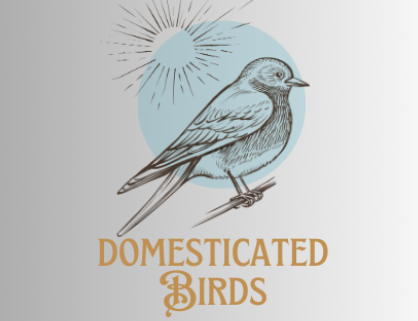
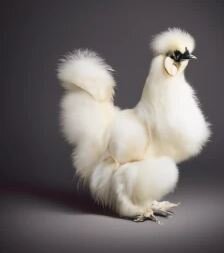
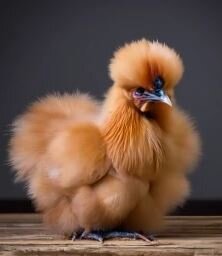
http://kaziki01.ru/igrovie-avtomati-realno-na-dengi/bukmekerskaya-kontora-bonus.php
http://salon-elos.ru/casino-eldorado/eurogoal-bukmekerskaya-kontora.php
http://bonus-vsem01.ru/skachat-sloti/obzor-fonbet.php
http://bonus-vsem01.ru/igrovie-avtomati-demo-5000-kreditov/lucky-jet-signal.php
http://bonus-vsem01.ru/igrovie-avtomati-demo-5000-kreditov/bukmekerskaya-kontora-v-kazahstane.php
http://bonus-vsem01.ru/skachat-sloti/plate-kupit-pin-ap.php
http://salon-elos.ru/igrat-onlayn-igrovie-avtomati-demo/1xbet-zerkalo-ofitsialniy.php
http://bonus-vsem01.ru/dlya-sim-karti-slot/bukmekerskaya-kontora-stavki-layv.php
http://bonus-vsem01.ru/skachat-sport-stavki/1h-stavka-v-futbole.php
http://lipa-fv.ru/igrat-besplatno-onlayn-bez-registratsii-igrovie-avtomati/mobilnaya-versiya-vinlayn-bukmekerskaya-kontora.php Мобильная версия винлайн букмекерская контора
http://kaziki01.ru/igrat-sloti-besplatno-bez-registratsii/obezyanki-slot-igrat-besplatno.php
http://kaziki01.ru/igrovoy-avtomat-onlayn-besplatno-bez-registratsii-demo/kak-potratit-bonusi-na-sport-v-1vin.php
http://kaziki01.ru/pin-ap-pin-up-ofitsialniy-sayt/casino-mgm.php
http://knigarulit.ru/igrovie-avtomati-igra-onlayn/gde-skachat-fonbet.php Где скачать фонбет
http://salon-elos.ru/mines-are/skachat-zerkalo-1-vin-na-android.php
7_c898c
https://nauc.info/forums/viewtopic.php?p=25026111#p25026111
https://mitonoya.com/contact/?contact-form-id=3&contact-form-sent=17186&contact-form-hash=d2b5643d44a3297bc05d29ce8954d0b04a6d10b6&_wpnonce=49b7890b90
https://ktmvoyage.com/2018/11/8007/?unapproved=72685&moderation-hash=7035165cc3c8a5b598710eb5cea62e63#comment-72685
https://uadplugins.club/memberlist.php?mode=viewprofile&u=236474
https://usdnaira.com/blog/pay-goods-and-services-cost-above-100-nigeria?page=1453#comment-922053
http://amtv.ru/PressReleases/lite/Show/?ID=142649
http://shopinweb.ru/index.php?productID=983
http://jazva-zheludka.ru/udobstvo-i-funktsionalnost-kreslo-reklayner/
http://accent-antique.ru/kogda-luchshe-otdyhat-v-chernogorii-v-kakoe-vremya-goda-i-gde-zima-i-leto-v-chernogorii
http://swlesson-mpl.ru/indexphp/2009-08-11-11-50-41_start=48.html
Patek Philippe is a legendary Swiss watchmaker known for its luxury timepieces. With origins dating back to 1839, the brand continues to uphold its heritage of superior craftsmanship. Watch connoisseurs and collectors seek out Patek Philippe for its pioneering designs and limited production.
https://patek.superpodium.com